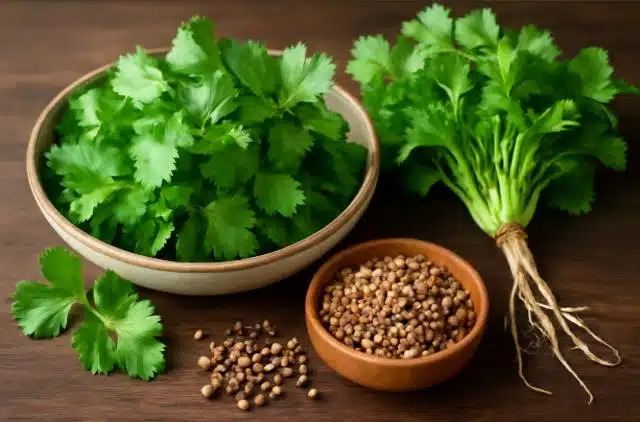Are you ready to elevate your culinary game? Enter Koriandri, the herb that adds flair and flavor to dishes around the world. Often known as coriander, this vibrant green plant is more than just a garnish; it’s a powerhouse of taste and nutrition. Whether you’re whipping up an exotic curry or refreshing salsa, Koriandri will transform your meals into unforgettable experiences. Join us on a flavorful journey through its history, health benefits, and creative recipes that will inspire you to incorporate this versatile herb into your daily cooking!
Overview of Coriander and Koriandri
Coriander, often referred to as Koriandri in various cultures, is a herb that graces kitchens worldwide. Its leaves and seeds are both used in cooking, offering distinct flavors that can range from bright and citrusy to warm and nutty. The fresh leaves are commonly found in salads and garnishes, while the seeds are typically ground into spice blends.
This dual-purpose plant belongs to the Apiaceae family. It thrives in warm climates, boasting a unique aroma that captivates food lovers everywhere. Whether you’re familiar with it or just discovering its wonders, Koriandri adds depth to any dish it’s part of.
Description and Appearance
Koriandri, also known as coriander, is a herb that boasts vibrant green leaves and delicate white to pink flowers. The leaves are often used fresh in culinary dishes, while the seeds have a warm, peppery flavor when dried.
The entire plant can reach heights of about 24 inches. Its feathery leaflets create an attractive burst of freshness on any plate, making it visually appealing as well as flavorful. This unique appearance adds charm to various dishes around the globe.
Origin and History
Koriandri, known as coriander in many parts of the world, has a rich history that dates back thousands of years. It is believed to have originated in regions spanning Southern Europe and North Africa. Ancient Egyptians used it not just for culinary purposes but also for its medicinal properties, often found in tombs alongside mummies.
Over time, this aromatic herb spread across continents. In India and other Asian countries, Koriandri became integral to vibrant cuisines. The spice trade helped popularize it globally; today, it’s celebrated for its unique flavor and versatility in various dishes around the world.
Health Benefits and Nutritional Value
Koriandri, or coriander, is packed with health benefits and nutritional value. Rich in antioxidants, it helps combat oxidative stress in the body. This herb is a great source of vitamins A, C, and K, which support immune function and skin health.
Additionally, koriandri offers essential minerals like potassium and magnesium that help regulate blood pressure. Its anti-inflammatory properties may aid digestion and alleviate discomfort from digestive issues. Incorporating this fragrant herb into your meals not only enhances flavor but also promotes well-being through its impressive nutrient profile.
Culinary Exploration
Koriandri is a versatile herb that can transform the flavor profile of various dishes. Its unique citrusy and peppery notes make it a favorite among chefs looking to add depth to their culinary creations. From fresh salsas to aromatic curries, this herb elevates any meal with its vibrant taste.
Experimenting with Koriandri opens up a world of possibilities. Try it in salads for a refreshing twist or blend it into sauces for an extra kick. The herb’s pairing potential is endless, making your cooking journey both exciting and flavorful.
Global Popularity and Significance
Koriandri, known as cilantro in some regions, enjoys immense popularity across the globe. From Mexican salsas to Indian curries, this herb adds a unique flair to countless dishes. Its vibrant flavor and bright green leaves have made it a staple in various cuisines.
Beyond its culinary impact, koriandri holds cultural significance in many societies. It’s often used in traditional rituals and celebrations, symbolizing freshness and vitality. This beloved herb not only enhances meals but also connects people through shared flavors and experiences worldwide.
Incorporating Koriandri into Daily Cooking
Koriandri can effortlessly elevate your culinary creations. Start by adding fresh leaves to salads, salsas, or guacamole for a burst of flavor. Its vibrant green color and distinctive aroma bring dishes to life.
You can also incorporate koriandri in marinades or dressings. Blend it with yogurt, garlic, and lemon juice for a delicious dip. Whether you’re preparing curries or soups, this herb enhances the overall taste profile while providing freshness that’s hard to resist. The versatility of koriandri makes it an essential ingredient in everyday cooking adventures.
Unique Taste and Culinary Uses
Koriandri offers a unique flavor profile that can be both refreshing and bold. Its citrusy notes blend beautifully with earthy spices, making it a staple in various cuisines. The fresh leaves are often used as a garnish or ingredient in salads, salsas, and curries.
Beyond its fresh form, dried Koriandri seeds have their own distinct character. They provide warmth and depth to spice blends and marinades. This versatility allows Koriandri to enhance everything from soups to roasted vegetables, bridging flavors across global culinary traditions effortlessly.
Diverse Cultural Perspectives
Koriandri, or coriander, transcends borders with its unique flavor and significance. In Mexico, it’s a staple in salsa verde and garnishes for tacos. Meanwhile, Middle Eastern cuisine celebrates it as a core ingredient in dishes like tabbouleh and falafel. Each culture brings its own twist to this herb.
In Asian countries such as India and Thailand, koriandri is often used fresh to add brightness to curries and soups. The diverse culinary applications highlight how this herb unites flavors across continents while also reflecting local traditions and tastes. Its versatility makes it a beloved choice worldwide.
Love-It-or-Hate-It Herb in Culinary World
Koriandri, or coriander, is one herb that stirs passionate opinions. Some adore its fresh, citrusy flavor that brightens dishes and elevates their profiles. For these enthusiasts, koriandri can transform a mundane meal into something spectacular.
On the flip side, there are those who cannot stand it. The taste often evokes strong reactions; many describe it as soapy or pungent. This divide makes koriandri a polarizing ingredient in kitchens worldwide, with chefs either celebrating its boldness or avoiding it altogether in favor of more neutral herbs.
Cultural and Religious Significance
Koriandri holds deep cultural and religious significance in various traditions. In many Asian cultures, it symbolizes purity and is often used in rituals to cleanse the spirit. Its vibrant leaves are seen as a bridge between the physical and spiritual worlds, enhancing offerings at ceremonies.
In some Middle Eastern communities, koriandri represents hospitality and abundance. It’s frequently featured in festive dishes served during special occasions or family gatherings. This aromatic herb connects people through shared culinary experiences while honoring age-old customs that transcend generations.
Growing and Using Koriandri
Growing koriandri is a rewarding experience for any home gardener. This herb thrives in well-draining soil and requires plenty of sunlight. You can start with seeds or small plants, ensuring they are spaced adequately to encourage growth. Regular watering is essential, but be careful not to overdo it; soggy roots can lead to disease.
Once harvested, koriandri offers endless culinary possibilities. Fresh leaves add brightness to salads, salsas, and curries. The seeds provide an earthy flavor when ground into spice blends or used whole in pickles. Embrace this versatile herb to elevate your dishes effortlessly.
Growing Tips at Home
Growing Koriandri at home is simple and rewarding. Start with well-drained soil, ideally enriched with compost. Choose a sunny spot in your garden or use pots if space is limited. The seeds germinate best in temperatures between 65-75°F.
Water regularly but avoid overwatering to prevent root rot. Thin out seedlings to allow ample spacing for growth. Harvest leaves when they’re young for the best flavor, and don’t forget that both leaves and seeds are edible! With just a little care, you can enjoy fresh Koriandri right from your own kitchen garden.
Creative Recipes and Innovations
Koriandri brings a vibrant touch to various dishes, inspiring culinary innovations that excite the palate. Think beyond traditional uses; try blending fresh koriandri into your guacamole or incorporating it into a zesty salsa for an unexpected twist.
For those adventurous in the kitchen, consider infusing oils with koriandri or creating unique marinades for meats and vegetables. The herb can also elevate simple salads when tossed with citrus vinaigrettes or used as a garnish atop soups. Koriandri’s versatility adds depth and character to countless recipes waiting to be explored.
Future of Koriandri Beyond the Kitchen
Koriandri is more than just a culinary staple; its versatility extends beyond the kitchen. As food trends evolve, so does the popularity of this herb. Innovative chefs and home cooks alike are exploring unique applications in beverages, desserts, and even beauty products.
Savvy mixologists are infusing cocktails with koriandri for an unexpected twist. Its bright flavor can elevate drinks to new heights. Additionally, creative bakers experiment by incorporating it into sweet treats like cookies or cakes.
The future also looks promising in wellness circles where koriandri’s health benefits shine through. Expect to see it as a key ingredient in smoothies and supplements aimed at boosting immunity.
Culinary enthusiasts will continue to celebrate this love-it-or-hate-it herb while discovering its role in sustainable cooking practices. Koriandri’s journey is far from over; it’s on the verge of making waves across various sectors, showcasing its lasting influence both on plates and beyond.

